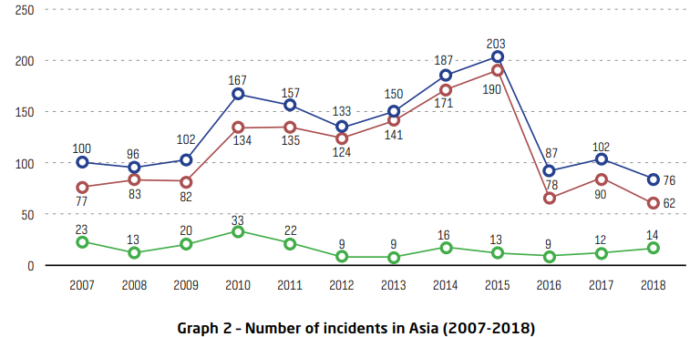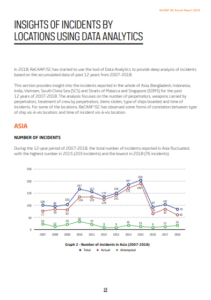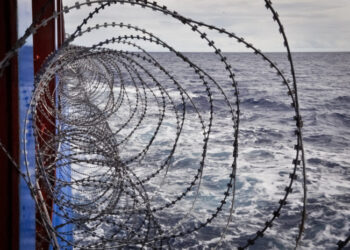In 2018, ReCAAP ISC started using Data Analytics to provide a deeper analysis of incidents based on the data it gathered in the last 12 years from 2007-2018. The report provides insights for incidents reported in the whole of Asia, Bangladesh, Indonesia, India, Vietnam, South China Sea (SCS) and Straits of Malacca and Singapore (SOMS).
The analysis gives emphasis on the number of perpetrators, weapons carried by perpetrators, treatment of crew by perpetrators, items stolen, type of ships boarded and time of incidents.
Asia
Number of incidents: During the period 2007-2018, the number of incidents reported in Asia fluctuated, with the highest number being reported in 2015 (203 incidents) and the lowest in 2018 (76 incidents).
[smlsubform prepend=”GET THE SAFETY4SEA IN YOUR INBOX!” showname=false emailtxt=”” emailholder=”Enter your email address” showsubmit=true submittxt=”Submit” jsthanks=false thankyou=”Thank you for subscribing to our mailing list”]
Insights: 76 incidents were reported in 2018. The type of incidents reported in 2018 were consistent with past trends regarding the number of perpetrators (4-6 men), type of weapons carried by perpetrators (knives/machetes), treatment of crew (no injuries), items lost (ship stores), type of ships boarded (tankers and bulk carriers) and time of incidents (during hours of darkness in the early hours of between 0000 and 0559 hrs).
Type of ships: As for what ships were attacked in 2018, most of the incidents (72%) took placeon board either tankers or bulk carriers. This is consistent with the past 11-year trend of incidents (63%).
Bangladesh
Number of incidents: The number of incidents reported in Bangladesh fluctuated as well, with the highest number reported in 2010 (24 incidents) and the lowest in 2016 (two incidents). However, there was a slight improvement in 2018 with nine actual incidents reported compared to 11 actual incidents in 2017.
Insights: 11 incidents were reported in 2018. The type of incidents reported in 2018 were consistent with past trends observed during 2007-2017 related to the type of weapons carried by perpetrators (knives/machetes/others), treatment of crew (no injuries), items lost (ship stores), type of ships boarded (container ships and bulk carriers) and time of incidents (during hours of darkness between 0000 and 0459 hrs). The analysis also indicates the correlation between the type of ships boarded and the location of incidents (at Anchorage A, B and C off Chittagong).
Type of ships: In 2018, most of the incidents (67%) happened on board either container ships or bulk carriers. This is consistent with the past 11-year trend of incidents (60%).
India
Number of incidents: The number of actual incidents reported (3) in India in 2018 was the lowest number during the 12-year period of 2007-2018.
Insights: 4 incidents were reported in India in 2018. The types of incidents reported in 2018 were consistent with past trends in terms of weapons that the perpetrators carried (not armed or not stated), treatment of crew (no injuries), items lost (ship stores) and type of ships (tankers).
Two of the four incidents reported in 2018 happened during daylight hours. This is a deviation from past trend where most incidents took place during hours of darkness.
Type of ships: The majority (50%) of the incidents reported in 2018 occurred on board tankers. This is consistent with the past 11-year trend (59%).
Indonesia
Number of incidents: 27 incidents (21 actual and six attempted) were reported in 2018. There was a reduction of 18% in the total number of incidents in 2018 compared to 2017.
Insights: 27 incidents were reported in 2018. These incidents were consistent with past trends observed during 2007-2017, in terms of number of perpetrators (4-6 men), treatment of crew (no injuries or not stated), items lost (ship stores), type of ships (tankers and bulk carriers) and time of incidents (between 2200 hrs and 0559 hrs).
Moreover, incidents involving tankers happened across various ports and anchorages in Indonesia, while incidents involving bulk carriers occurred mostly along the coast of East Kalimantan; and incidents involving tug boats/supply vessels occurred off Pulau Batam and Pulau Bintan.
Type of ships: Most of the incidents (74%) reported in 2018 occurred on board bulk carriers. During 2007-2017, 43% of the incidents that happened on board tankers and 34% occurred on board bulk carriers. There is a slight deviation as more tankers than bulk carriers were boarded in the last 11 years (2007- 2017).
Vietnam
Number of incidents: 4 actual incidents were reported in 2018. This was a rise of 50% compared to 2017 when two incidents were reported. However, there was an improvement of the situation in Vietnam over the past three years (2016-2018).
Insights: Incidents reported in 2018 in Vietnam were consistent with the past trends observed during 2007- 2017, regarding the number of perpetrators (1-3 men), treatment of crew (no injuries), items lost (ship stores) and type of ships (container ships and bulk carriers).
Nevertheless, there is a slight deviation regarding the time of incidents as two-thirds of the incidents reported in 2018 took place during daylight hours; while most of the incidents in past 11-years occurred during hours of darkness. Incidents on board container ships and tankers occurred more often in the southern part of Vietnam than in the northern part.
Type of ships: All four incidents reported in 2018 involved bulk carriers. During 2007-2017, 39 incidents (38%) were reported on board container ships, 35 (34%) on board bulk carriers and 18 (17%) on board tankers.
South China Sea (SCS)
Number of incidents: 4 incidents (three actual and one attempted) were reported in SCS in 2018. Compared to 2017 there has been a 67% reduction in the number of incidents reported in 2018. In 2017, 12 incidents (11 actual and one attempted) were reported. 2018 reported the lowest number of incidents among the 12-year period of 2007-2018.
Insights: Incidents reported in 2018 in SCS were consistent with the past trends observed during 2007- 2017, as for the number of perpetrators (4-6 men), treatment of crew (no injuries), and time of incidents (between 0000 hrs and 0559 hrs). There is also a slight deviation regarding the weapons carried by perpetrators and items lost.
The majority of incidents in 2018 had no information on whether the perpetrators were armed while during 2007-2017, more than half of the incidents involved armed perpetrators.
As far as the loss of items is concerned, majority of incidents in 2018 reported nothing was stolen while the loss of cash and personal belongings were prevalent in incidents reported during 2007-2017. Incidents were relatively less violent in 2018 compared to the past 11-years.
Type of ships: Of the four incidents reported in 2018, one happened on board a bulk carrier, one on board a tanker, one on board a general cargo ship and one on board a catamaran. This is different from the past 11-year trend where 82 incidents (52%) took place on board tankers, 28 (18%) on board tug boat/supply vessels and 19 (12%) on board bulk carriers.
Straits of Malacca & Singapore (SOMS)
Number of incidents: 8 incidents (six actual and two attempted) were reported in SOMS in 2018. In comparison to 2017 where 9 incidents were reported, the number of incidents reported in 2018 had remained similar.
Insights: Incidents in 2018 were consistent with the past trends observed during 2007- 2017, in terms of number of perpetrators (4-6 men), weapons carried by perpetrators (not stated), treatment of crew (no injuries), items lost (50% reported nothing stolen), type of ships mostly boarded (tug boats/supply vessels, bulk carriers and tankers) and time of incidents (between 2300 hrs and 0459 hrs).
Type of ships: Of the eight incidents reported in 2018, three occurred on board tug boats towing barges, two on board bulk carriers, two on board tankers and one on board a workboat.
No deviation was reported from the trend, as 33% of incidents in the past 11 years took place on board tug boats/supply vessels, 28% on board bulk carriers and 25% on board tankers.
See more information in the PDF below





























































